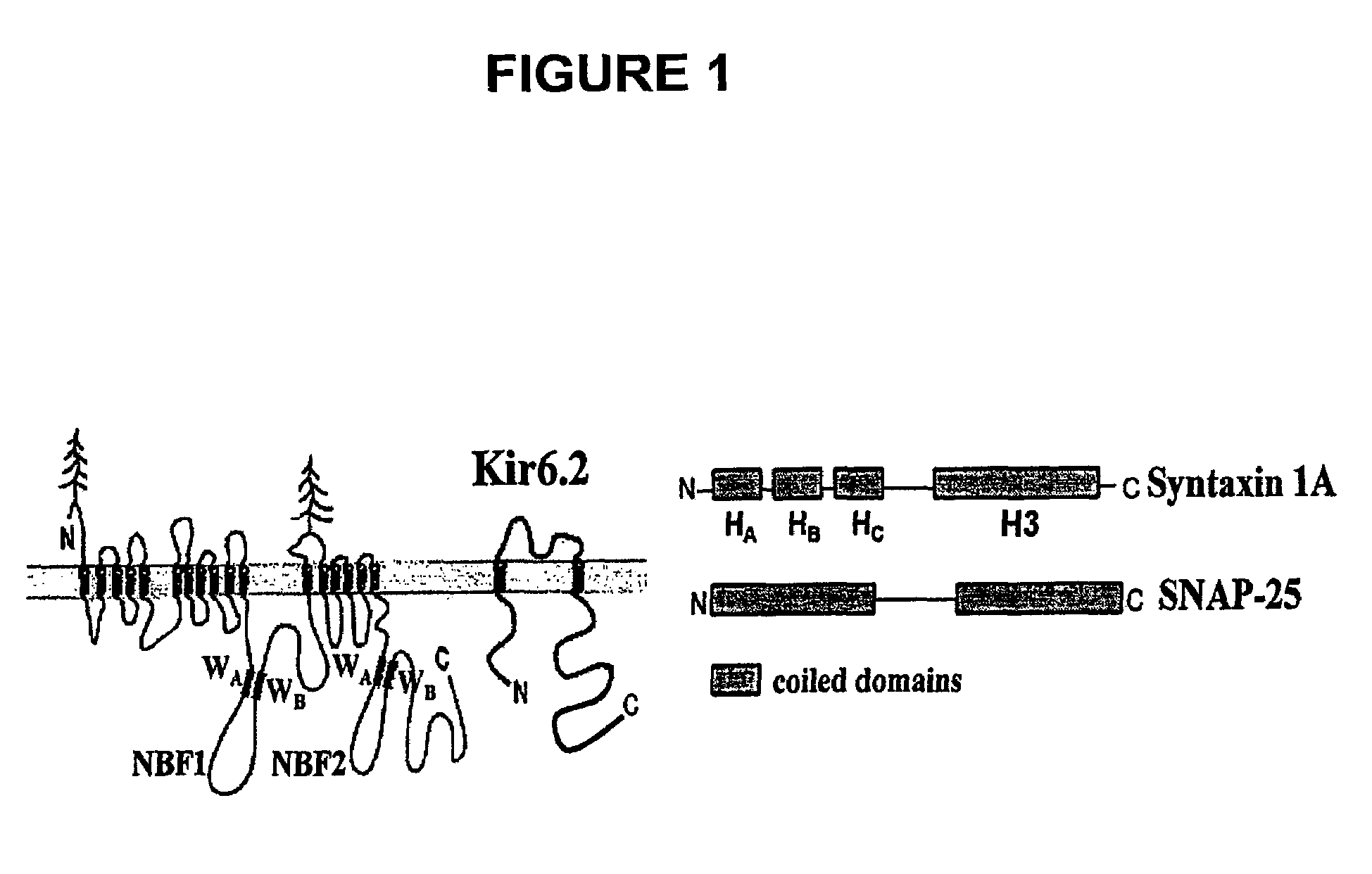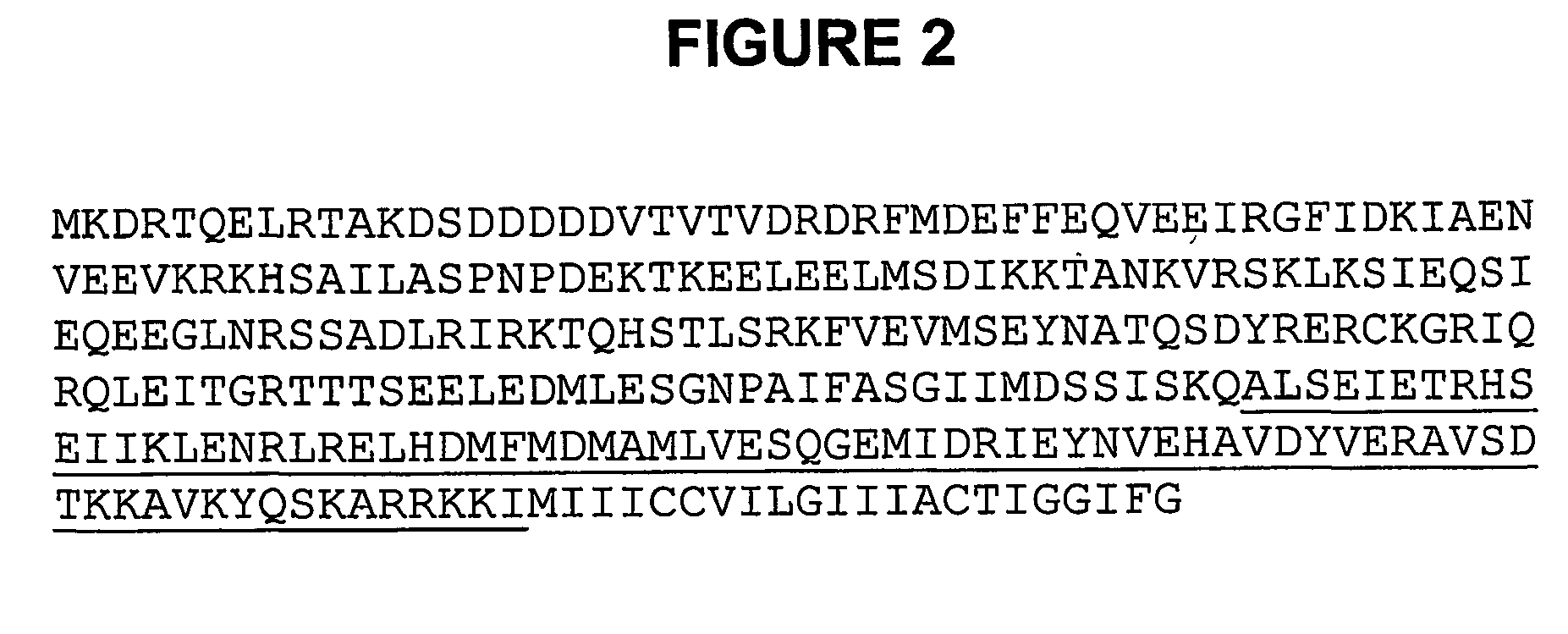Drug target within the sulfonylurea receptor
a sulfonylurea receptor and drug target technology, applied in the field of compounds, can solve the problems of shortening the duration of membrane action potentials, reducing casup>2+, and reducing contraction and energy consumption
- Summary
- Abstract
- Description
- Claims
- Application Information
AI Technical Summary
Benefits of technology
Problems solved by technology
Method used
Image
Examples
example 1
Nucleotide Binding Fold 1 (NBF-1) and NBF-2 of Both SUR-1 and SUR-2A Directly Bind Syntaxin-1A (Syn-1A)
[0130]GST (control) or GST-NBF-1 or GST-NBF-2 (375 pmol protein)of SUR-1 or SUR-2A, bound to glutathione beads, was incubated with Syn-1A or SNAP-25 (375 pmol protein) in 25 mM Hepes (pH 7.4) with 50 mM NaCl, 0.1% gelatin, 0.1% Triton X-100, 0.1% BSA and 0.2% β-mercaptoethanol at 4° C. for 2 hours. Following washing the beads three times with 20 mM Hepes(pH 7.4) with 150 mM KoAc, 1 mM EDTA, 1 mM MgCl2, 5% glycerol and 0.1% Triton X-100, the samples were subjected to 15% SDS-PAGE, transferred to nitrocellulose membrane and probed with antibody against Syn-1A (1:2000) or SNAP-25 (1:1000).
[0131]Results: NBF-1 and NBF-2 of SUR1 (shown in FIG. 6A) and of SUR2A (shown in FIG. 6B) directly ‘pulled’ down Syntaxin 1A, and therefore the binding of these proteins are direct. This binding is specific since GST and GST-SNAP-25 did not pull down the NBF-1 or NBF-2 of either SUR1 or SUR2A.
example 2
Syntaxin-1A is Located on the Plasma Membrane of Rat Cardiac Muscle Cells
[0132]Confocal microscopy shows that syntaxin-1A is located on the plasma membrane of a cardiac muscle cell (see FIG. 7A). Syntaxin-1A was also found in the purified enriched plasma membrane fraction of rat cardiac muscles (see FIG. 7B). 100 mg protein of plasma membrane fraction, with rat brain homogenates (5 mg) used as a positive control, was separated by SDS-PAGE, and the separated proteins identified by anti-syntaxin antibodies. In FIG. 7B syntaxin-1A (black arrow) and syntaxin-1B (white arrow) are identified.
example 3
Syntaxin 1A Modulates Insulinoma HIT Cell KATP Channel Activity in an ATP- and ADP-Dependent Manner
[0133]Representative KATP whole-cell patch-clamp currents recorded from the control and syntaxin-1A overespressing HIT cells are shown in FIG. 6A. Cells were stimulated by voltage steps from −140 to 0 mV from a holding potential of −50 mV. Glybenclamide (0.1 mM) reduced the current amplitude in the control cell (n=4). The currents recorded from the HIT cell transfected with syntaxin-1A were also reduced compared with the control cells (n=10). Arrows show the presence of another type of K+ current (a large conductance outward current) activated at 0 mV. The corresponding current-voltage (I-V) relationships and shown in FIG. 6B: (filled circles) control, (diamonds) glybenclamide, (open circles) syntaxin-1A. All currents were recorded 15 min after the formation of the whole-cell configuration when a cell interior exchanged with the pipette solution containing low (0.3 mM) ATP concentratio...
PUM
 Login to View More
Login to View More Abstract
Description
Claims
Application Information
 Login to View More
Login to View More - R&D
- Intellectual Property
- Life Sciences
- Materials
- Tech Scout
- Unparalleled Data Quality
- Higher Quality Content
- 60% Fewer Hallucinations
Browse by: Latest US Patents, China's latest patents, Technical Efficacy Thesaurus, Application Domain, Technology Topic, Popular Technical Reports.
© 2025 PatSnap. All rights reserved.Legal|Privacy policy|Modern Slavery Act Transparency Statement|Sitemap|About US| Contact US: help@patsnap.com



